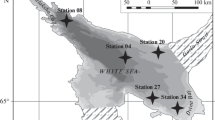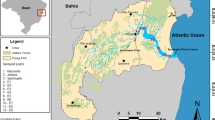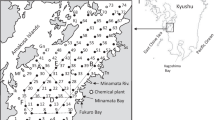Abstract
Horizontal and vertical distributions of mercury were determined in seawater in Minamata Bay and Yatsushiro Sea. The concentrations of total and particulate mercury respectively ranged from 56–285 ng l−1 and 2.1–506 ng l−1. They were both highest in the inner most part of Minamata Bay where the sediment was most heavily polluted, and decreased with increasing distance from there. Vertically, an evident increase in concentration was observed near the bottom. A good agreement was found between the mercury content in suspended matter and that in fine sediment particles.
These facts show that the particulate mercury is supplied mostly from the bottom sediment, and that it is spreading offshore with dispersing in seawater. This process would eventually result in the pollution of sediment in Yatsushiro Sea.
Similar content being viewed by others
References
Bothner, M. H. andD. E. Robertson (1975): Mercury contamination of sea water samples stored in polyethylene containers. Anal. Chem.,47, 592–595.
Environment Agency (1974): Survey of Mercury Pollution of Ariake Sea, Yatsushiro Sea and Minamata Bay, 105 pp. (in Japanese).
Fitzgerald, F. andW. B. Lyons (1975): Mercury concentrations in open-ocean waters—Sampling procedure. Limnol. Oceanogr.20, 468–471.
Hirota, R., M. Fujiki andS. Tajima (1974): Mercury contents of the plankton collected in Ariake- and Yatsushiro-kai. Bull. Japanese Soc. Sci. Fisheries,40, 393–397 (in Japanese).
Hosohara, K., H. Uezuma, K. Kawasaki andT. Tsuruta (1961): Studies on the total amount of mercury in sea waters. Nippon Kagaku Zasshi,81, 1479–1480 (in Japanese).
Irukayama, K., M. Fujiki, S. Tajima andS. Omori (1972): Transition of pollution with mercury of the sea food and sediments in Minamata Bay. Nippon Koshu-eisei Zasshi,19, 25–31 (in Japanese).
Knauer, G. A. andJ. H. Martin (1972): Mercury in a marine pelagic food chain. Limnol. Oceanogr.,17, 868–876.
Kumamoto Prefecture (1976): Environmental Impact Assessment of the Reclamation of Minamata Harbor, 252 pp. (in Japanese).
Matida, Y. andH. Kumada (1969): Distribution of mercury in water, bottom mud and aquatic organisms of Minamata Bay, the River Agano and other water bodies in Japan. Bull. Freshwater Fish. Res. Lab.,19, 73–93.
Matsunaga, K. (1975): Effect of variation of mercury concentrations in waters on them in aquatic organisms. Mizushori-Gijutsu,16, 639–645 (in Japanese).
Matsunaga, K., M. Nishimura andS. Konishi (1975): Mercury in the Kuroshio and Oyashio regions and the Japan Sea. Nature,258, p. 224.
Nishimura, M., K. Matsunaga andS. Konishi (1975): Determination of mercury in natural waters. Bunseki Kagaku,24, 655–658 (in Japanese).
ólafsson, J. (1974): Determination of nanogram quantities of mercury in sea water. Anal. Chim. Acta,68, 207–211.
Author information
Authors and Affiliations
Rights and permissions
About this article
Cite this article
Kumagai, M., Nishimura, H. Mercury distribution in seawater in Minamata Bay and the origin of particulate mercury. Journal of the Oceanographical Society of Japan 34, 50–56 (1978). https://doi.org/10.1007/BF02108658
Received:
Revised:
Accepted:
Issue Date:
DOI: https://doi.org/10.1007/BF02108658




